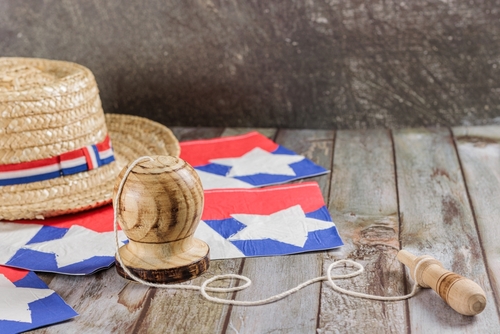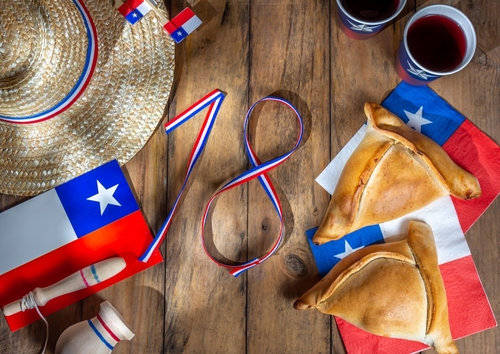Chile Independence Day, known locally as Fiestas Patrias, represents one of South America’s most vibrant national celebrations. This multi-day festival honors Chile’s independence from Spanish colonial rule and showcases the country’s rich cultural heritage through food, music, dance, and community gatherings.
Whether you’re planning to experience the festivities in Chile or celebrate with Chilean communities worldwide, understanding the traditions and significance of this holiday will help you participate meaningfully. The celebration officially takes place on September 18th, but the festivities often extend through September 19th and sometimes into the weekend.
For those with family in Chile or Chilean heritage abroad, this holiday provides an excellent opportunity to connect with loved ones and share in cultural traditions. Understanding the customs and ways to participate can make your celebration more authentic and meaningful.
Understanding Chile’s Independence History
Chile declared its independence on September 18, 1810, marking the beginning of the end of Spanish colonial rule. This date commemorates when the First Government Junta was established in Santiago, initiating the process that would lead to full independence.
The independence process wasn’t immediate. It took several years of struggle, led by heroes like Bernardo O’Higgins and José de San Martín, before Chile achieved complete sovereignty. September 19th is also celebrated as Armed Forces Day, honoring the military’s role in securing and protecting the nation’s independence.
These historical events shaped modern Chile and continue to influence how Chileans celebrate their national identity. The pride in overcoming colonial rule and establishing a sovereign nation remains central to the festivities.
Traditional Celebrations and Customs
Fondas and Ramadas
The heart of Chile Independence Day celebrations takes place in fondas and ramadas—temporary structures set up in parks, plazas, and neighborhoods. These festive venues feature traditional music, dancing, games, and food stalls.
Fondas typically offer more organized entertainment, while ramadas tend to be smaller, community-based gatherings. Both provide spaces for families and friends to come together and celebrate Chilean culture.
These venues operate throughout the celebration period, often from early September through the end of the month. They serve as cultural hubs where people of all ages can participate in traditional activities.
Cueca Dancing
The cueca, Chile’s national dance, takes center stage during Independence Day celebrations. This courtship dance involves pairs of dancers using handkerchiefs and following specific steps that tell the story of a rooster courting a hen.
Learning basic cueca steps can enhance your celebration experience. Many communities offer dance lessons leading up to the holiday, and participating in group dances creates a strong sense of cultural connection.
The dance requires no special skills—enthusiasm and willingness to participate matter more than perfect technique. Most fondas and ramadas feature cueca competitions and group dancing opportunities.
Traditional Games
Chilean Independence Day features several traditional games that bring communities together. These activities provide entertainment for all ages and help preserve cultural traditions.
Palo ensebado involves climbing a greased pole to reach prizes at the top. This challenging game requires teamwork and persistence, making it a crowd favorite.
Rayuela, similar to horseshoes, involves throwing metal discs at a target. This game combines skill with social interaction, as players often engage in friendly banter during matches.
Sack races, three-legged races, and other traditional games create opportunities for family participation and community bonding.

Essential Foods for Your Celebration
Empanadas
Empanadas de pino represent the most iconic food of Chilean Independence Day. These baked pastries contain a filling of ground beef, onions, hard-boiled eggs, olives, and raisins, seasoned with traditional spices.
Making empanadas requires time and preparation, but the process often becomes a family activity. Many Chilean families gather the day before to prepare large batches together.
If making empanadas from scratch seems challenging, many Latin American grocery stores sell frozen versions, or you can find recipes online that simplify the process.
Asado (Barbecue)
Chilean asado features grilled meats, particularly beef and pork, prepared with simple seasonings that highlight the meat’s natural flavors. The social aspect of gathering around the grill creates an important part of the celebration.
Traditional sides include pebre (a spicy salsa), fresh bread, and simple salads. The focus remains on quality ingredients and shared meals rather than complex preparations.
Planning an asado requires adequate outdoor space and time for slow cooking, but the communal experience makes it worthwhile for group celebrations.
Traditional Drinks
Chicha, a fermented beverage made from grapes or apples, serves as the traditional drink of choice. This mildly alcoholic beverage has deep historical roots in Chilean culture.
Pisco sour, Chile’s national cocktail, offers another popular option. Made with pisco (Chilean brandy), lemon juice, sugar, and egg white, this cocktail represents Chilean drinking culture.
For non-alcoholic options, fresh fruit juices and traditional herbal teas provide authentic alternatives that everyone can enjoy.
How to Celebrate Outside Chile
Finding Chilean Communities
Many cities worldwide host Chilean communities that organize Independence Day celebrations. These events often take place in community centers, parks, or cultural organizations.
Contact local Chilean consulates or cultural centers to find celebration information in your area. Social media groups for Chilean expatriates also provide excellent resources for finding events.
Participating in organized community events offers the best opportunity to experience authentic traditions and meet people who share Chilean heritage.
Creating Your Own Celebration
If no organized events exist in your area, creating your own celebration can be equally meaningful. Focus on incorporating key elements: traditional food, music, and cultural activities.
Invite friends and family to share in the experience, regardless of their cultural background. Explaining the significance of traditions while participating helps preserve and share Chilean culture.
Simple decorations using Chilean flag colors (red, white, and blue) and playing traditional music creates an authentic atmosphere for your celebration.
Connecting with Family in Chile
For those with family in Chile, Independence Day provides an excellent opportunity to strengthen connections. Video calls during celebrations allow you to share experiences across distances.
Consider coordinating celebration times to share meals virtually or exchange photos and videos of your respective celebrations. These connections help maintain cultural ties and family relationships.
Sending remittances to family members in Chile for their Independence Day celebrations shows support and care. This practical gesture helps loved ones participate fully in local festivities.
Planning Your 2025 Celebration
Important Dates
September 18, 2025, falls on a Thursday, with September 19 following on Friday. This creates an extended weekend opportunity for celebrations, as many people will have Monday, September 22, off as well.
Plan activities across multiple days to fully experience the traditional celebration period. Start with food preparation early in the week, allowing time for empanada making and other cooking tasks.
Book any necessary venues or make restaurant reservations early, as Chilean Independence Day celebrations have grown in popularity worldwide.
Essential Supplies
Create a shopping list that includes ingredients for traditional foods, Chilean flag decorations, and music for dancing. Many specialty items may require ordering in advance from Latin American grocery stores.
Consider purchasing or borrowing items needed for traditional games if you plan to include these activities in your celebration. Simple props can be made at home with basic materials.
Prepare a playlist of traditional Chilean music, including cueca songs and popular folk music, to create an authentic atmosphere throughout your celebration.
Frequently Asked Questions
What is the difference between Chilean Independence Day and other Latin American independence celebrations?
Chilean Independence Day focuses specifically on the cueca dance, empanadas de pino, and the historical significance of September 18, 1810. While many Latin American countries share similar colonial histories, Chile’s celebration emphasizes unique cultural elements like fondas and ramadas, and specific traditional games that distinguish it from other independence celebrations.
Can non-Chileans participate in Independence Day celebrations?
Absolutely. Chilean communities worldwide welcome people of all backgrounds to join their Independence Day celebrations. Participating respectfully by learning about the traditions, trying traditional foods, and joining in dances and games is encouraged. Many Chilean expatriate communities use these celebrations as opportunities to share their culture with their new neighbors.
How long do Chilean Independence Day celebrations typically last?
Official celebrations occur on September 18-19, but many communities extend festivities throughout the entire month of September. In Chile, the celebration period is often called “el mes de la patria” (the month of the homeland). Fondas and ramadas may operate for weeks, allowing people to celebrate multiple times throughout the period.
What should I wear to a Chilean Independence Day celebration?
Traditional Chilean clothing isn’t required, but many people choose to wear colors of the Chilean flag (red, white, and blue) or traditional outfits if they have them. Women might wear traditional dresses for cueca dancing, while men often wear typical Chilean cowboy attire called “huaso” clothing. Comfortable shoes are essential for dancing and participating in games.
How can I learn to make authentic empanadas de pino?
Start with online recipes from reputable Chilean cooking websites or cookbooks. Many Chilean cultural centers offer cooking classes leading up to Independence Day. The key ingredients include ground beef, onions, hard-boiled eggs, black olives, and raisins, seasoned with cumin and paprika. Practice making the dough and filling separately before attempting to assemble them.
Celebrating Chilean Heritage and Culture
Chilean Independence Day offers more than just a party—it provides an opportunity to connect with rich cultural traditions and strengthen community bonds. Whether you’re celebrating in Chile or abroad, participating in these time-honored customs helps preserve important cultural heritage.
The celebration emphasizes family, community, and national pride through shared experiences of food, music, and dance. These elements create lasting memories and strengthen cultural identity for Chilean families worldwide.
Start planning your 2025 celebration early to ensure you have everything needed for an authentic and meaningful experience. Remember that the most important aspect is bringing people together to honor Chilean culture and independence.
For those sending money to family in Chile to support their celebrations, reliable international transfer services can help ensure your contributions arrive safely and on time for the festivities.

